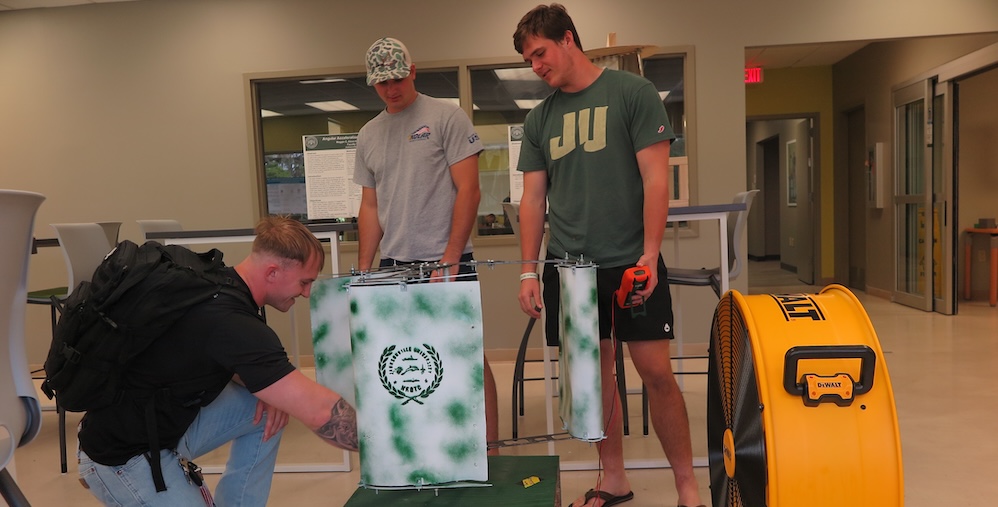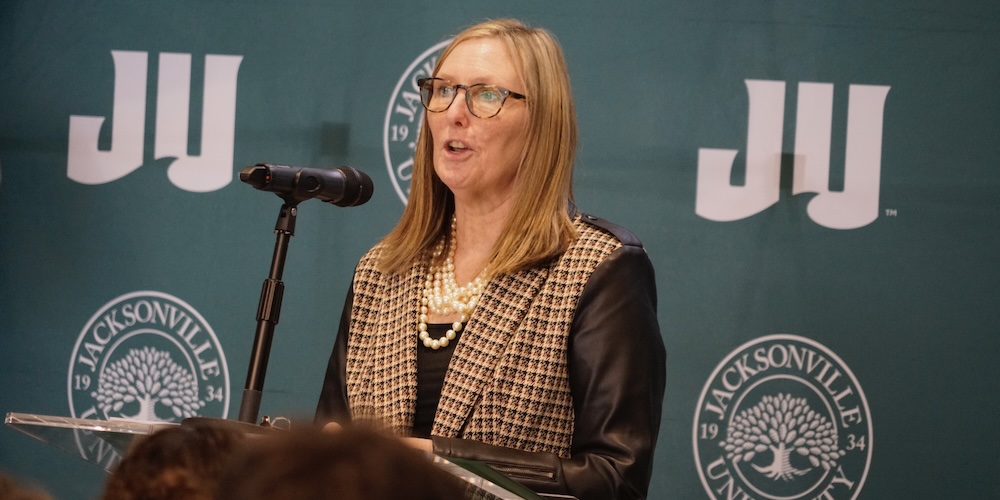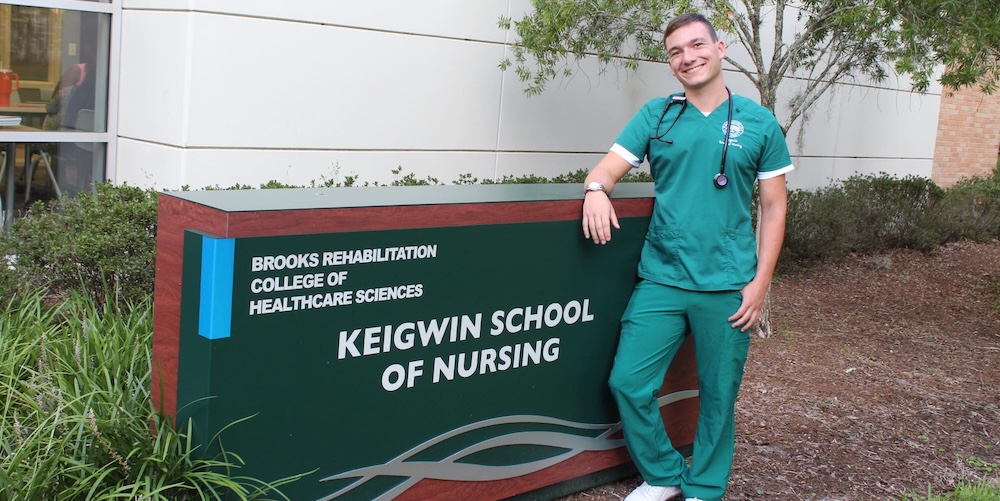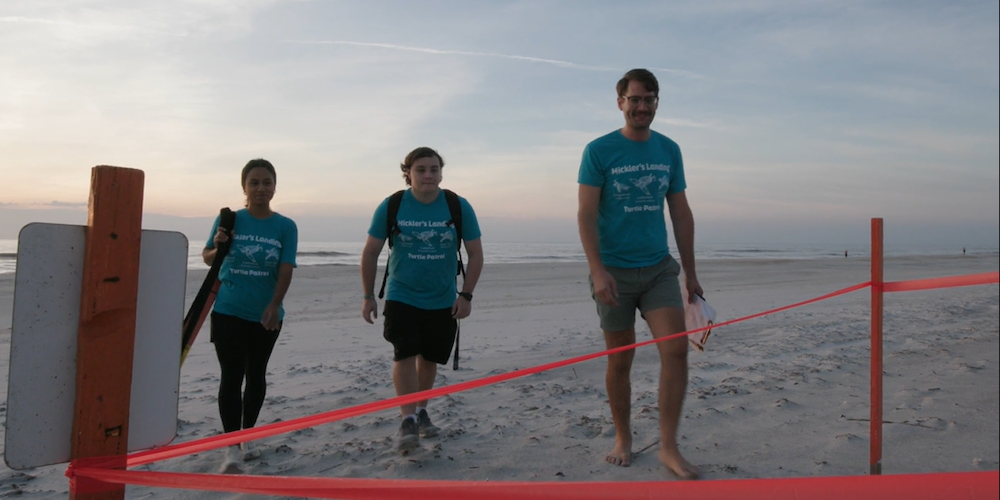What started out as a small-scale project last semester turned into a much larger one this semester in Dr. John Bruce and Peter Bohn’s Design for Reliability and Manufacturability course. The task: Sophomore mechanical and electrical engineering students in the Davis College of Business and Technology were challenged with creating a scaled version of a wind harvesting device.
The teams began by studying what creates wind currents, the history of wind turbine development and then deriving the basic mathematical equations for wind turbines and generators, which convert mechanical energy to electrical.
From there, eight teams created design concepts, did trade-off studies and created performance requirements for their final designs. Each team then built and tested a unique solution to creating a scaled wind turbine. Bohn, engineering teaching lab instructor, said the goal was to give the students experience working in different parts of a team, taking a project from concept to reality.
The teams experienced great takeaways from the hands-on project. Student Stefanos Pappas said other than teamwork skills, he learned how to properly account for manufacturability when trying to transform an idea on paper into something tangible.
“When creating a design of something you want to prototype, the main focus needs to be manufacturability. It must be easy to assemble and easy to manufacture,” he said. Pappas was on Team KAS, also comprised of Avery Biggerstaff and Kennedy Rowley.
Will Sorensen, part of Team B.R.U.C.E., says a big problem engineers encounter is overdesigning devices. He learned to simplify his drawings and system to get the best output.
“If you go through the Design for Manufacturing and Assembly levels, it eliminates parts that are just there to be there, so it makes your project as simple as possible and most efficient,” noted Sorenson, whose team members included Colin Koneski and Evan Sharpe.
Team and interpersonal relationship skills was one takeaway for Shane Gillis. “A lot of this project has proven to be challenging from an academic and an interpersonal level, but I’ve learned a lot about applying theoretical concepts that we’ve learned,” he said. Gillis’ team, Team Current Cavaliers, also included students Nadia Candelaria and Ethan Simpson.
Although the teams created solid products, they had their share of challenges along the way. Time management and scheduling seemed to be at the top of the list for a few teams. “We had to do a lot of communicating and scheduling to get it done right. We ended up creating a really useful product,” said Sorenson.
Gillis shared that time management was a challenge for his team, especially in the building phase. “We had only 16 weeks to come up with customer requirements and to build to those requirements and meet those requirements,” he explained. “Being able to meet the demands of a project of that proportion in 16 weeks, and only two weeks to build, was difficult.”
According to Bruce, the teams were very creative and successful in accomplishing the goals of the project. “The students gained a tremendous amount of experience in designing, building and testing reliable manufacturable sustainable products,” he stated.
Gillis said that Bruce and Bohn were always there to help the teams along. “Once we went out on our own and designed our projects, they were there almost like peers, helping us to solve problems and think through our designs,” he said.
Bohn says the School of Engineering faculty develops the curriculum in order to get students’ real-world experience. “A lot of engineering programs have students where they’ve done a lot of work on paper with all the math that goes into it, but they haven’t been able to apply it into a real-world situation.”
A project like the wind turbine project gives students hard skills, like analyzing the manufacturability of a project or coming up with requirements given to them by a customer and effectively communicating to a group of people. “There are so many different aspects of a project like this that makes our engineers who complete these projects very valuable to a company, even at entry level,” Bohn said.
The students feel that hands-on experiences like the wind turbine project are helping prepare them for their future careers.
Being able to break down big problems and ideas into small manageable tasks is something Gillis feels he’s learned and can take with him into the workforce, "whether that be on a personal level or having a scheduling conflict or timing issue."
Pappas believes the skills he’s developed in the classroom working as a team will make it easier to work with colleagues who might have different expertise or backgrounds than he does, as well as applying the design process. “The process of how we’re taught to identify a problem, design a solution and carry it through to the end will be the biggest thing I carry with me into a real-life environment.”



